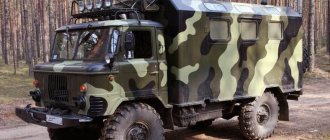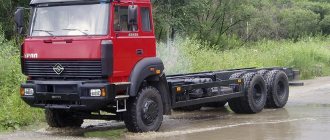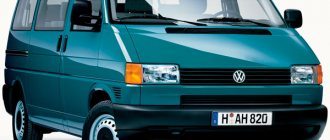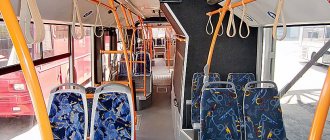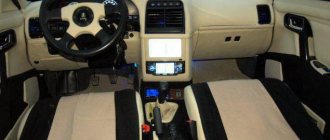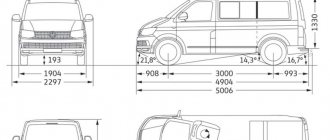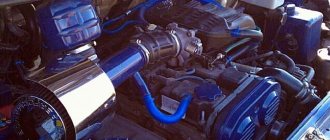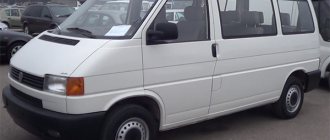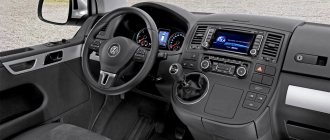Since I went through all the steps when purchasing my bead, I decided to write instructions on what to do if you want to purchase a T3.
The first and most valuable advice, if you suddenly look at a bead, do not buy it under any circumstances! Turn around and forget, it will be better for you. Buy a normal car, some Solaris on credit, and don’t worry about driving. You don’t need beads and now I’ll explain why:
- You won’t be able to buy it for a hundred dollars in excellent condition, tweak it a little in the garage and drive it.
- Don’t even expect to get a body in good condition: it is either rusty and needs to be redone, or it has already been repaired with crooked hands and needs to be redone again.
- Don’t even hope that “I’ll fix it up a little and tint it” - most people are not able to do it themselves, but give it to the Armenians or the crooked Vasyas - they will have to redo everything in a year, but specialists who do it well will charge 300 thousand for the job of restoring the body .
- With a high degree of probability, you will have a dead or half-dead engine: they were used, but they were hardly serviced properly. Consider that a new engine (not new, of course, but a contract one, with an unknown history and with a 50/50 chance of being dead) costs from 40 with installation.
- The box is a weak point, it will probably also not be in the best condition, the spare parts for it look like they are made of precious metals. But you can find contract figs and they cost from 30 (again, in a condition unknown to anyone).
- For obvious reasons, you probably won’t get a salon that’s 30 years old either - it’s been trashed, but it costs like the interior of a death star.
- You won’t be able to buy it and carry manure in the village: it will break, and you won’t have enough money to fix it, and in the end it will rot.
- As a result, such a bus will cost 400-500 rubles. At the same time, it will be a car that has certain problems and is still old, something will fly and will definitely constantly suck money.
If you have read all this and it hasn’t stopped you, you are deliberately going to buy, or you are so hurt that I want to live, I can’t live, I don’t care about money, read on - what should you, poor fellows, do now :)
History of creation
The first minibus from Volkswagen with excellent driving characteristics was developed in the first half of 1979. Unlike its predecessors, this vehicle was more spacious. Depending on the modification, the dimensions of the T3 Transporter had different indicators. In particular, the parameters of the Caravelle T3 are as follows: 1844x4569x1928 mm.
Since the mid-1980s. Air conditioning began to be installed on minibuses, which will create comfortable conditions for passengers in the cabin. From this time period, the Syncro model began to have all-wheel drive. The car was equipped with electric windows. It was possible to automatically adjust the exterior rear view mirrors. It should be noted that there are windshield wipers. The installation of an anti-lock braking system has been introduced since 1986, which increases the degree of safety when maneuvering. Thanks to technical improvements, the car began to experience impressive smoothness.
Tuning headlights and taillights
Restoring and improving the T3 transporter is a pleasant task, if only because its optics diameter is standard - 178 mm. This makes it easy to find what you need. Even spare parts from Soviet cars fit it. All this is sold at a low price.
Read also Tuning Volkswagen T4
To replace, you can take optics that are suitable for the price - Polish Wesem ones are popular. But both buses and passenger cars from most manufacturers are suitable. Headbands and other small additions are easy to find - new or used.
The problem can only arise with the fastenings. Will have to customize.
An important addition is fog lights. They can also be ordered on the website that sells Wesem.
Buying taillights is not a problem. You can find original ones at a salvage shop or buy new ones.
Gaskets
Gasoline versions (50-112 hp) are of greatest interest to collectors. This is the last Volkswagen equipped with petrol boxer engines. Until 1982, the engines were air-cooled, and after that they were liquid-cooled. The former turned out to be more reliable, although they suffered from oil leaks. It is worth noting that in cars with air-cooled engines, the interior is never warm in winter.
Cars with liquid-cooled engines can be recognized by an additional radiator grille that appears directly above the front bumper. Unfortunately, in units of this type, the cylinder head bolts often corroded and the cylinder head gaskets burned out. In addition, the radiator is located in the front, and the “pipes” often leak. In the worst case, problems arose long before 100,000 km. Daily inspection of the cooling system is a mandatory ritual.
Reliable 2.1-liter boxer engine with electronic injection and water cooling. Consumption of 14-16 liters in the city is the norm, not the exception. With good care, it can last 250-300 thousand km. The rules are the same as for turbo engines: after loading, do not turn off immediately, but let it run for 1-2 minutes.
For serious purposes, it is better to consider options with diesel engines. They are good for covering long distances, although they are much louder. By the way, diesel engines have the usual in-line arrangement of cylinders. The most offers on the market are with 1.7 D and 1.6 TD engines. Turbodiesel with a volume of 1.6 liters and output of 70 hp. too weak. In addition, it is not highly reliable. The cylinder head shows chronic weakness, and with age, the turbine is not in the best condition.
At one time, many owners installed 1.9 TD or even 1.9 TDI instead of these units. With such a source of traction, the Volkswagen T3 is more peppy, more reliable, and burns almost the same amount of fuel. True, in order to introduce a 1.9-liter turbodiesel, you have to cut out some metal. The engine simply doesn't fit. Some even installed engines from Subaru.
Body tuning and body kits for Volkswagen T3
Tuning the body will help give the car a more modern look, but you will need to think separately about the aerodynamic characteristics.
Body kits really improve speed performance. But their effect becomes noticeable only at high speed. Therefore, for the Transporter T3 it is more realistic to select additions that will update its appearance. Speeds can only be taken care of when replacing the engine along the way.
There are now many websites offering elegant body kits for the T3 at an affordable price. You can also buy:
- spoilers, deflectors
- bumper covers (or completely new ones)
- headlight covers, eyelashes
- radiator grilles, sills
- much more.
For the 3rd generation Transporter, body tuning should begin with treating corrosion areas. The transporter bodies were not galvanized, but many of the vehicles were well preserved even after significant use. But there is still rust - you need to carefully inspect all surfaces and treat them.
Some owners spray anti-corrosion agents between the inner surface of the body and the trim.
At the end of the article you can see photos taken by the owners of the transporters. They did most of the work with their own hands - and this is what came out of the old T3s.
Chassis Transporter T3
The vehicle is equipped with a gear steering rack, which has a decent margin of safety. In the early 1990s, the Carat version began to feature power steering, which greatly facilitates movement. All mechanisms related to steering are distinguished by their quality. Due to the fact that Volkswagen began to be equipped with a power steering system, maneuvers on the road began to be carried out easier and more efficiently.
The suspension provides an optimal level of maneuverability on the roadway. The front axle includes double wishbones (triangular) with coil springs. On the rear axle there are oblique levers with springs. The suspension copes well with increased loads. Volkswagen Transporter T3 shock absorbers with springs dampen vibrations and minimize vibrations and shaking that occur during a trip. The car behaves steadily on the road. The running gears installed on the foreign car provide decent driving dynamics.
Disc mechanisms can be installed on the front axle, and drum mechanisms can be installed on the rear axle. They comply with all safety standards and are characterized by high strength.
Tuning the VW T3 interior
You're lucky if all the problems come down to only internal work. The interior decoration is carried out to increase comfort and safety, and here restrictions can only be on the funds that are planned to be invested.
You can leave everything original (if the condition is decent or can be cosmetically restored), and for convenience, change the steering wheel, which can easily be found at disassembly sites. An adapter is purchased for it, as well as a hydraulic booster, which was not on the conveyors of the early 1980s.
The car has a small base, the seats of passenger cars are suitable for it - better than German ones, they are closer to the standards.
Many owners change door cards. The interior is also soundproofed.
Malfunctions
If you adhere to an aggressive driving style, deformation of the pads or discs may occur, resulting in an increase in stopping distance. The surface of the brake elements must be free of corrosion, chips, etc. Hoses must be checked for tightness and integrity; if damaged, brake fluid will leak.
It is worth making an appointment for diagnostics of the steering system in the following cases:
- Difficulty turning the steering wheel;
- After parking the car, oil smudges began to be noted on the asphalt;
- Deterioration in controllability;
- There were knocking noises in the front of the car.
As a rule, these symptoms indicate a broken steering rack; there may be torn boots that need to be replaced. Regular checking of the power steering system helps reduce the risk of an emergency.
Despite the fact that the car has a standard factory anti-corrosion coating, over time, the car owner may encounter body corrosion at the welds.
The average resource of the Volkswagen Transporter T3 gearbox is 15,0000 km. By this time, its main components will wear out, and as a result, difficulty switching gears and jerking (noise) will begin to be noted. Gearbox repair is necessary if oil leakage occurs. Also, it is necessary to monitor the level of filled fuel. Do not forget about timely replacement of spark plugs and filters.
During long-term use of the vehicle, condensation may form inside the optics or haze may form on the outside, which will interfere with lighting. In this case, the headlight needs to be replaced.
Volkswagen Caravel: what to look for when buying
I’ll look at what you need to look at using the example of one of the copies that I looked at, but refused to buy:
- Despite the fact that you saw HIM, your head is already shaking, drooling, you need to pull yourself together and carefully study the documents (Registration Certificate and PTS) and what is written in them. Everything inside and out must correspond to what is on the car.
- We go with the PTS to look at the VIN, it is located under the sliding door on the bottom, if you look on the right there will be a crossbar, the VIN is knocked out right in the middle - often you will not immediately find it under a layer of dirt.
Having wiped off the dirt, it is better to do this with a wet rag, you need to look at the condition of the VIN: it must be clearly readable, have no nicks, very deep scratches, traces of welding/cutting (including the cross member itself), and most importantly - corrosion (the car is not new, this place is open to all kinds of dirt and salt). In the photo there should be no problems with the VIN - there is only surface corrosion, the symbols are easy to read (if you buy it, cover it with grease, as I did - it will be more intact).Remember, you should not clean metal with a hard brush - problems with registration may arise and they may be sent for examination. So, the VIN must match the PTS and SOP and be unambiguously readable! No options! Otherwise, you simply will not be able to register the car, or you will succeed, at the cost of considerable time and money.
- Next, let's look at the engine: you need to check the engine number with what is written in the vehicle title. The engine number on diesel engines is located on the right wall of the block immediately under the cylinder head in the upper corner on cylinder 4 (closer to the box). The number should be easy to read, without clogged numbers, scratches, etc., and, of course, match the number on the PTS.
On the example I looked at, the original 1.6 JX engine is a naturally aspirated diesel engine, which was also indicated in the PTS, but in fact it turned out that it costs 1.9d, which was purchased to replace the dead JX, but which, despite the capital (had to to do because the engine turned out to be dead), it never worked normally (more on that below). The original engine was lying in the garage, as it turned out.Thus, in order to register it, it was necessary to make changes to the title, or remove the engine that is standing, stick in the original dead one, register it (by somehow dragging a bus to the traffic police), and then repair one of the engines and install it (and 1.9 make changes anyway, and this plus money). In fact, the bus turned out to be without an engine, someone inattentive could easily miss this moment and get in the way. After all, the bus was sold at the price of a problem-free one with a running engine. In fact, the traffic police would have turned us in with a different engine.
- There is also a plate with the body number on the body. It is located on the left A-pillar at the feet of the front passenger, riveted. The plate must be in place, readable and the number must match what is indicated in the documents.
- Some of the information can be obtained on a sticker under the fuse box on the cross member under the panel (located under the block to the left of the steering column) - it indicates the engine, gearbox, equipment, as well as the option codes with which the car left the factory. Transcripts can be viewed on the Internet. It’s better if it turns out that they coincide with what’s actually on the bus. In the case of the example I looked at, there was only a sticker about tires and pressure on the left front pillar.
- Having made sure that everything is legally clean, the numbers are present, readable, match, we look at the most expensive part of the car - its body. The T3 has a monocoque body, but there is essentially an integrated frame, cross members and longitudinal parts; as a rule, it is in good condition, unless there have been serious accidents - this is what we need to find out. We climb under the car and begin to look: along the entire length there should be no traces of handicraft welding, crooked, crumpled parts, or severely corroded lesions. We also look at the external body panels. On this example, it was immediately clear that it had been hit in the front part, hard, and more than once: traces of repeated handicraft painting were visible, the putty was chipped off, and it was painted over again with a brush.
In addition, they have a problem: the windshield frame rusts, the glass begins to flow, does not stay in the opening, and the geometry is disrupted. This is easy to determine - it can be seen either with the naked eye, or you can see it by bending the molding from the bottom left. This is all obvious. Yes, in addition, there are traces of paint on the rubber band, broken glass is visible (we think in our minds that you will have to eliminate this), and there are traces of sealant under the molding - this is what they do when it starts leaking due to rust. This means there is a real problem there, the frame will need to be digested at least in this corner. - The next problem area is the running boards: moisture from the feet always accumulates there, a puddle forms, plus all the crap from the road gets on them. We look at them from below and assess their condition. In this case, on the right is the original iron, but with through corrosion.
- Along the way, we notice another problem area - the joints of the body panels and the opening of the tank filler flap, plus rust along the edges of the arches:
- We open the door and see a makeshift repair under the rug: riveted iron to cover the through holes will have to be cut out and welded.
- The next place is under the passenger's carpet, bend it and the upholstery on the arch. Often there is corrosion from moisture from the feet. There's a hole through here, you'll have to digest the entire pool.
- In the door opening there are traces of impact and the door being locked to the body, plus sagging doors. The geometry of the openings is also worth assessing - this is the key to safety and not a crooked body. Doors should close and open easily without distortion or touching the body.
- As expected, on the driver’s side everything is even sadder - pieces of iron screwed onto self-tapping screws, the original iron is all in holes
There's also trouble under the driver's feet
So that the reader does not faint, I will not show what was happening at the gas pedal - this is the most problematic place - moisture and dirt from the feet flows onto the floor pedal and, over time, turns the floor into a sieve, so that the pedal is held on the word of honor or on a piece of iron , riveted on top - these are typical problems and should definitely be looked at.
- Next is the bottom of the doors. There was rust here, but not the most critical one. Next - the bottom of the panels, the sills. All this needs to be assessed. The rear arches also don’t last long, the piece behind the rear wheel is almost certainly rusty, the joints are the problematic part.
We look at the rear panel under the bumper for geometry, rust, we look at the back door opening and gaps, the back door itself (the clapper) often rots along the bottom and around the lock, but it costs a lot. - The sliding door also rusts along the bottom. You need to look at the geometry of the opening. The door should close tightly and quite easily, although, for sure, the handle will be broken - here it was repaired, a mistake,
and the roller mechanism must be intact, otherwise it won’t work properly - there was through corrosion, the seals fell off and were torn.It was closed from the inside with a hook - you will have to buy all the locks, as well as the rollers, and also weld the bottom of the opening - it’s not cheap.
- We climb into the cabin: we evaluate the driver’s seat to see if everything is in place. This example contained a whole scattering of collective farm buttons: some were responsible for the backlight, some for the signal (it didn’t work on the steering wheel), some turned on the cooling fan (which means there are problems with cooling, since the fan does not turn on itself, and the engine overheats with 17 You still need to manage liters of coolant, most likely it’s already overheated - this should be one of the warning signs)
When starting up, it later turned out that some of the electrics in the panel also did not work - all this needs to be put in order, changed, and this costs money. I was pleased, however, by the pre-heater panel, which was later found under the hood - a rare thing and very useful for a diesel engine, but it did not work, for unknown reasons - We evaluate the condition of the seats - their upholstery. This one had covers, I partially removed them, the headrests turned out to be different colors, torn (they often tear), the seats were in relatively satisfactory condition. You also need to assess the condition of the floor in the passenger compartment - there is often rust there, especially at the seams. Belts must also be present - without them you will be turned away by the traffic police, and their fastenings must be reliable and factory-made. It’s worth taking a look and turning on the cabin heater - they are often full of holes and antifreeze oozes out, and the fan may not work.
- The body has the largest part on which serious accidents will be visible - the roof, which during strong impacts goes in waves or even humps, I climbed onto the front bumper and assessed
- If all this does not frighten you, then we ask you to start the engine (at our request, if possible, it should be cold), and we ourselves stand in the back. The engine should start easily after the spark plugs have warmed up after a short crank. In my case, it briskly lubricated, emitted either black or bluish smoke, but could not start... After replacing the battery, it did start, after prolonged oiling, but it produced such clouds of bluish smoke that it became clear that there was trouble. We will look for similar signs: there should be no bluish smoke or extraneous sounds. There shouldn't be a lot of black smoke either. Our patient worked unstably even at high speeds and smoked like your locomotive.
- Test Drive. If possible, you should carry it out yourself - this way you will understand how you like the bus in general, whether you can ride it, try the gearbox, pedals and steering wheel. But if it doesn’t work out, it’s okay - we ask the owner to take it for a ride. In this case, you need to watch how the box turns on: is there a crunch, is it holding with your hand, are the gears flying out - these are symptoms of a dying box. You also need to evaluate the hum from it - it should not be howling. At the same time, we look at the owner’s driving style - this will tell a lot about how the bus was used. While driving, you need to assess whether the bus is able to drive straight - whether you have to hold it with the steering wheel, whether the steering wheel is straight - such signs can be easily solved, but can lead to irreversible consequences and large investments. We listen to the chassis - are there any knocks, blows, is it swaying, is there a hum from the bearings - if there are signs, we need to further diagnose or bargain, or understand how much it will cost. By the way, before the trip, it wouldn’t hurt to evaluate the geometry of the wheels - neither the rear nor the front should stand in a noticeable little house, they should stand at the same angle (very small to the eye). Be sure to look at how it brakes - whether it needs to be pumped, whether the brake pedal travel is long - jammed current cylinders, problems with the GTZ are not uncommon.
- After the test drive, we turn off the engine and go look under the hood. We look at the condition of the collective farm in the pipes, the general condition externally, the condition of the collective farm in the wiring, the condition of the belts, especially the timing belt, we look for fluid leaks - oil will tell about the seals and gaskets, antifreeze - about the cooling system, etc. - all this is important and gives an understanding of how the car was serviced .
For example, I saw snot in the wiring, haphazardly, without clamps, fixed fuel hoses were not in the best condition, pipes that were obviously replaced from Russian cars, some of them were cracked. You need to check the oil: level, thick black or, on the contrary, fresh clean, metal particles, strong burning smell, foam, drops of antifreeze or water - should be very alarming. Also, with the engine running, you need to touch the pipes - they should not be stone, and there should be no smoke, bubbles or oil in the expansion tank, and the level should be normal - this often happens due to overheating and a broken gasket. In my case, the engine was overheated and was lying in the garage - even replacing the head (which leads to cracks) or another injection pump did not help. There were also problems with the new engine - it didn’t really start when cold, although it did when it was hot (that’s why I asked it not to start), it smoked and didn’t develop power. Someone had to deal with all this... - The gearbox will also need to be inspected as far as possible - leaks, oil seals, CV joints, boots, hydraulic clutch.
I guess here, despite the long text (who even read at least half of it?), I described only part of the problems and did not talk about many - some of them are the same as on other cars and are fair to everyone. Some of these are individual problems of specific specimens. I tried to write about problems typical of this model, which sooner or later everyone will have and we need to be prepared for them. I deliberately did not indicate the amounts, because they can vary greatly depending on your capabilities, region and specific case. But, one way or another, I believe that before making a balanced purchase, you need to take into account all the shortcomings found on the car (you will not be able to detect some of them and they will pop up during operation) and count the amount that you will spend on eliminating these problems and already then make a decision - whether you need it or not, whether you can afford it financially or not.
For the most part (rather, even the overwhelming majority), it turns out that buying such a car is not economically profitable, since it will ultimately cost the same as the same Solaris. But at the same time it will remain old and unreliable. Therefore, I ask you again, do not buy this car, but buy a normal one, ready to immediately transport your precious carcass. If you didn’t listen and are ready to take a risk - welcome to hell, the ranks of happy T3 owners - these inadequate, but cheerful people will help you with advice and give you goodies and maybe even help you with their pens along the way. They are no longer treated and do not sell (as a rule) these cars, they are in nirvana and there is no need to prove anything to them - let them drive, repair, especially since the cars are decent, interesting and not boring. Technically unusual in many ways and legendary in their own way. Pay attention to us, rejoice, point your finger up!
I hope the post was helpful in choosing (or refusing such a choice). See you on the roads, thank you for getting through the long, chaotic text.
About the condition in which I bought my Erbusik
Cool article? Share!
Author: Yuri (Er...)
expert on cars and motorcycles in Perm
About me
Prices for Transporter T3
Owners are offered the choice of purchasing a car with rear-wheel drive, the average price of which is in the range of 150,000-300,000 rubles. Used, worn-out cars cost about 3-4 times cheaper. The price of vehicles with front-wheel drive can exceed 500,000 rubles, and for exclusive models 1 million rubles.
Thus, this is a maneuverable type of transport equipped with high-quality working mechanisms. The suspension allows you to quickly overcome any uneven roads and creates optimal conditions for all passengers in the cabin. The car is characterized by high reliability. Later generations of the Volkswagen Transporter T3 could be equipped with automatic transmission, ABS system, and air conditioning. It is suitable for families, groups of friends to go on vacation, or for organizing excursions.
On vacation
Will the VW T3 allow you to spend time comfortably on a long trip? Quite if it turns out to be a version of Caravelle or, even better, Caravelle Carat. Large and roomy interior, velor upholstery, improved sound insulation, six comfortable separate seats. A 2.1-liter water-cooled boxer engine gurgles imperceptibly from behind. When you press the gas pedal deeper, it sounds almost as beautiful as the engine of a Porsche 911. Although this car is definitely lacking in temperament. But this unit is perhaps the fastest.
The Carat version is intended primarily for lovers of good equipment. At the turn of the late 80s and early 90s, the minivan received power steering, air conditioning, power windows and an audio system. Simpler modifications could not boast of anything similar.
The limited edition Multivan Whitestar Carat looks no less luxurious: twin headlights, alloy wheels and large plastic bumpers painted in body color. Here the interior is more practical - equipped with a folding sofa bed and a coffee table. Such a car allowed me to save on hotel costs, and in the middle of the week it courageously solved everyday problems.
Westfalia is designed for picnic trips. Inside there is a gas stove, a refrigerator and a folding roof with canvas walls. The model is easily recognized by its roof add-on. In addition to these modifications, the following versions were offered: Joker, California and Atlantica.
Another interesting option appeared in 1984 - Syncro. This is a minivan with all-wheel drive. Its vulnerable elements: viscous coupling and rear axle blocking. They required very costly repairs after 200,000 km.
Production in South Africa
After 1991, production of the VW T3 continued in South Africa until 2002. For the local South African market, VW renamed the T3 model Microbus. Here it underwent homologation - a slight “facelift”, which included large windows all around (their size was increased in comparison with models made for other markets) and a slightly modified dashboard. The European wasserboxer engines were replaced by 5-cylinder engines from Audi and updated 4-cylinder engines from VW. A 5-speed gearbox and 15″ wheels have been added as standard for all versions. To more effectively cope with the onslaught of the 5-cylinder engine, large ventilated front disc brakes were introduced. By the time production of the model was completed, exclusive versions similar to the European Multivan with a second row of seats rotated 180 degrees and a folding table appeared on sale.
